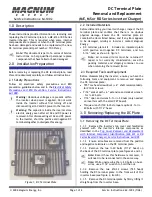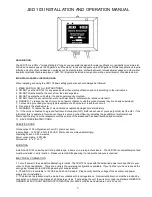
DP564 Multichannel Audio Decoder
Appendix A: Metadata
A-11
In each of these devices, the analog stereo output is one of two different stereo
downmixes. One type is a stereo-compatible Dolby Surround downmix (also called
Pro Logic
®
, left-total/right-total, or Lt/Rt) of the multichannel source program that is
suitable for Dolby Surround Pro Logic decoding. The other type is a simple stereo
representation (called a left-only/right-only, or Lo/Ro) suitable for playback on a
stereo hi-fi or on headphones, and from which a mono signal is derived for use on an
RF/Antenna output. The difference between the downmixes is how the surround
channels are handled. The Lt/Rt downmix sums the surround channels and adds them,
in-phase to the left channel and out-of-phase to the right channel. This allows a Dolby
Surround Pro Logic decoder to reconstruct the L/C/R/S channels for a Pro Logic
home theater. The Lo/Ro downmix adds the right and left surround channels
discretely to the left and right speaker channels. This preserves the stereo separation
for stereo-only monitoring and produces a mono-compatible signal. In all downmixes,
the LFE channel is not included.
On most home equipment, the consumer can use the product’s user interface to
choose the appropriate stereo output for their playback system. The mono signal
feeding the RF/Antenna output is always derived from the Lo/Ro downmix.
There are separate metadata parameters for the adjustment of the Lo/Ro and Lt/Rt
downmix conditions. Certain metadata parameters allow the engineer to select how
the stereo downmix is constructed and which stereo analog signal is preferred, but
Lt/Rt is the default selection in all consumer decoders. See Section A.5, Parameter
Definitions, for more information on individual parameters.
During downmixing, as we have seen, the adjustment of dynamic range control
parameters is limited. Broadly speaking, the stereo outputs use the Line Mode
compression profile and the mono signal uses RF Mode compression. As with
dynamic range control, downmixing is ultimately dependent upon each consumer’s
unique listening environment.
While the engineer must optimize the multichannel mix for reproduction in an ideal
listening environment, it is also important to preview the mix in downmixing
conditions to ensure compatibility with different playback systems when selecting the
downmixing metadata parameters. These previews can be achieved in real time using
the DP570 Multichannel Audio Tool.
A.5 Parameter
Definitions
Metadata parameters include:
•
Universal parameters
•
Extended Bitstream Information (Extended BSI) parameters
Extended BSI parameters are active only when the consumer’s decoder is capable of
reading them
and
when the producer chooses to use them. All decoders can
successfully decode a metadata stream without Extended BSI parameters, and
Summary of Contents for DP564
Page 1: ...Model DP564 Multichannel Audio Decoder User s Manual Issue 1 Part Number 91830...
Page 10: ...Virtual Dolby Technologies Test DVD Track List iv...
Page 14: ...Virtual Dolby Technologies Test DVD Track List iv...
Page 18: ...Virtual Dolby Technologies Test DVD Track List iv...
Page 26: ...Virtual Dolby Technologies Test DVD Track List iv...
Page 44: ...Virtual Dolby Technologies Test DVD Track List iv...
Page 54: ...Virtual Dolby Technologies Test DVD Track List iv...
Page 66: ...Virtual Dolby Technologies Test DVD Track List iv...
Page 98: ...Virtual Dolby Technologies Test DVD Track List iv...
















































